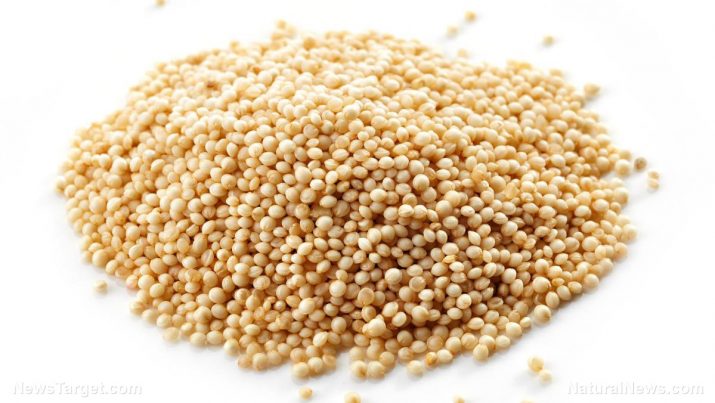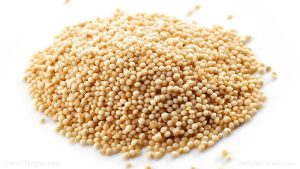
Amaranth – sources, health benefits, nutrients, uses and constituents at NaturalPedia.com
Wednesday, June 21, 2017 by Frances Bloomfield
http://www.naturalpedia.com/amaranth-sources-health-benefits-nutrients-uses-and-constituents-at-naturalpedia-com.html

Amaranth comes in many varieties, with some types considered a weed because of the plants’ aggressive nature and quick-growing speed. Among the indigenous peoples of Central America and Mexico, amaranth seeds have been valued as a staple food as a staple food for thousands of years. Amaranth was so revered by the Aztecs that they incorporated it into their religious rituals. Currently, amaranth is still being widely-grown and consumed in Central America. Its reputation as an excellent source of protein, vitamins, and minerals has helped it slowly gain popularity in other parts of the world, like North America and Europe. Though not a true grain, amaranth is considered a pseudo-cereal grain or pseudo-grain.

List of known nutrients
Amaranth has a high concentration of complete protein, with the protein content even extending to the leaves of the amaranth plant. This type of protein contains all of the essential amino acids, putting amaranth on the same level as meat and poultry. Amaranth is also full of:
- Antioxidants
- Calcium
- Carotenes
- Copper
- Folate
- Folic acid
- Iron
- Lysine
- Magnesium
- Monounsaturated fats
- Phytosterols
- Polyunsaturated fats
- Potassium
- Vitamin A
- Vitamin B2
- Vitamin B3
- Vitamin B6
- Vitamin K
- Zinc
Medicinal uses for amaranth
Amaranth has been and continues to be used to prevent the following ailments:
- Atherosclerosis
- Bleeding
- Cancer
- Congestion
- Diarrhea
- Gluten intolerance
- High cholesterol
- Menstruation
- Osteoporosis
- Type-2 diabetes
Body systems supported by amaranth
Consuming amaranth on a regular basis can assist in the protection and maintenance of:
- Bones
- Digestive system
- Endocrine system
- Eyes
- Heart
- Liver
- Lungs
Ways to use amaranth
Similar to healthy grains such as quinoa, there are a great variety of ways to add amaranth to one’s daily diet. The easiest way to consume amaranth is prepare it like stove-top popcorn and then mixing it with honey or coconut syrup for added flavor.
Those who want to eat more filling amaranth-heavy dishes are free to use it in any meal for any time of the day. Breakfast can be made heartier by using amaranth as a substitute for oatmeal or adding it to pancake batter. Amaranth also does well as a snack bar, as part of a salad, and even as the breading for fish sticks.
Note that amaranth contains a small amount of phytic acid, which is a phosphorus storage molecule that prevents the body from properly digesting and using the nutrients found in amaranth. To neutralize the phytic acid, it’s best to soak amaranth in water before cooking.
Where to learn more
- Five weeds that make better medicines than any pharmaceutical drug
- When the Spanish conquistadores arrived in the Americas, they forbade the cultivation of two of the world’s best sources of vegetable protein
- Amaranth: a gluten-free grain rich in protein and minerals
- Amaranth is a gluten-free and super healthy source of protein
- Dietary Restrictions: Workarounds For Food Allergies
Summary
As a rich source of calcium, amaranth can prevent osteoporosis.
Amaranth contains fiber and healthy unsaturated fats, including polyunsaturated and monounsaturated fats. Together, these substances can help balance cholesterol levels by lowering the amount of “bad” cholesterol clogging up the cardiovascular system.
Vitamin K is another heart health booster, and a vitamin that amaranth has in impressive amounts.
The fiber content in amaranth also makes it a good choice in supporting digestive health, as fiber ensures smooth food digestion and efficient mineral uptake.
Cataract formation and macular degeneration are two vision-related conditions that amaranth can prevent or slow down thanks to its vitamin A and carotene content.
Amaranth is naturally free of gluten, making it an ideal alternative grain source for people with Celiac’s disease or gluten intolerance.
Sources include:
WHFoods.org
LiveStrong.com
SunWarrior.com
OrganicFacts.net
Oola.com
Tagged Under: Tags: amaranth





